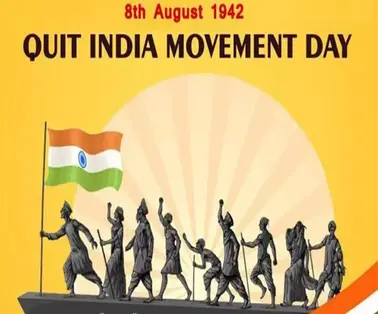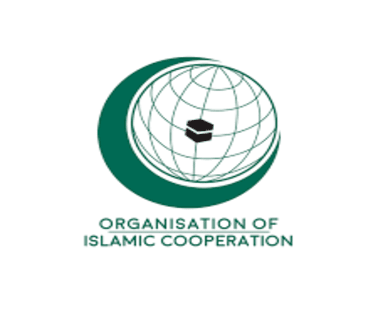What was the Quit India Movement?
- The movement is a major milestone in the history of India’s struggle for independence from the British rule.
- Floral tributes were paid to freedom fighters and others who laid down their lives in the freedom struggle.
- This is the same ground from where Mahatma Gandhi gave the clarion call of ‘do-or-die’ for independence.
- The movement in August 1942, with Mahatma Gandhi’s call for immediate independence, was launched at Mumbai’s Gowalia Tank, which later came to be known as August Kranti Maidan due to its association with the historic occasion.
When was the Quit India Movement launched?
- It is also known as the India August Movement or August Kranti.
- It was officially launched by the Indian National Congress (INC) led by Mahatma Gandhi on 8 August 1942.
- The movement gave the slogans ‘Quit India’ or ‘Bharat Chodo’. Gandhi gave the slogan to the people – ‘Do or die’.
- In line with the Congress ideology, it was supposed to be a peaceful non-violent movement aimed at urging the British to grant India independence.
- The Quit India Resolution was passed by the Congress Working Committee on 8 August 1942 in Bombay. Gandhi was named the movement’s leader.
- The resolution stated the provisions of the movement as:
- An immediate end to British rule over India.
- Declaration of the commitment of free India to defend itself against all kinds of imperialism and fascism.
- Formation of a provisional government of India after British withdrawal.
- Sanctioning a civil disobedience movement against British rule.
Quit India Movement Causes and Effects
- This movement had the active participation of women of the country. Aruna Asif Ali hoisted the national flag on the Gowalia tank maidan; Usha Mehta, on the other hand, helped set up the underground radio station to spread awareness about the movement.
- This movement also gave some future prominent leaders such as Biku Patnaik, Aruna Asif Ali, Ram Manohar Lohia, Sucheta Kriplani, J.P. Narayan, etc. These leaders were helping the movement through underground activities.
- A greater sense of unity and brotherhood emerged due to the Quit India Movement. Many students dropped out of schools and colleges, people gave up their jobs and withdrew money from the banks.
Failure Of The Quit India Movement
- The movement did not have the support of many organisations of the country itself.
- The Britishers were supported by the Princely States, British Indian Army, Indian Civil Services, Viceroy’s Council (which had Indians in the majority), All India Muslim League, Indian Imperial Police.
- The Hindu Mahasabha, Rashtriya Swayamsevak Sangh (RSS) & Muslim League also opposed the Quit India Movement.
- Many Congress members like C Rajagopalachari resigned from the provincial legislature as they did not favour Mahatma Gandhi’s idea.
Impact of the Quit India Movement on India’s independence
- The Quit India movement was violently suppressed by the British – people were shot, lathi-charged, villages burnt, and enormous fines imposed. In the five months up to December 1942, an estimated 60,000 people had been thrown in jail.
- However, though the movement was quelled, it changed the character of the Indian freedom struggle, with the masses rising up to articulate as they had never before – the British masters would have to Quit India.
Quit India Movement history
Cripps Mission
- Japanese aggression in South-East Asia, keenness of British Government to secure the full participation of India in the war, mounting pressure from China and the United States, as well as from the Labour Party in Britain, led British Prime Minister Winston Churchill to send Cripps Mission to India in March 1942.
- Under Stafford Cripps, the mission was sent to resolve the Indian question of a new constitution and self-government.
Main Proposals Of The Mission Were
- An Indian Union with a dominion status would be set up; it would be free to decide its relations with the Commonwealth and free to participate in the United Nations and other international bodies.
- A constituent assembly would be convened after the war to frame a new constitution.
- Members of the assembly partly elected by the provincial assemblies and partly nominated by the princes.
- Any province not willing to accept the constitution would be given ‘the same full status as the Indian Union’, – designed to appease the Muslim League’s call for Pakistan.
- The constitution making body and the British Government would negotiate a treaty to effect the transfer of power and to safeguard racial and religious minorities.
- The Indian National Congress, however, was not satisfied as its demand for immediate complete independence had been rejected.
- Mahatma Gandhi said that Cripps’ offer of Dominion Status after the war was a “post-dated cheque drawn on a failing bank’’.
Partition Of India And Pakistan
- At the conclusion of the Second World War, the Labour Party, under Prime Minister Clement Richard Attlee, came to power in Britain.
- The Labour Party was largely sympathetic towards Indian people for freedom. A Cabinet Mission was sent to India in March 1946, which after a careful study of the Indian political scenario, proposed the formation of an interim Government and convening of a Constituent Assembly comprising members elected by the provincial legislatures and nominees of the Indian states.
- An interim Government was formed headed by Jawaharlal Nehru. However, the Muslim League refused to participate in the deliberations of the Constituent Assembly and pressed for the separate state for Pakistan.
- Lord Mountbatten, the Viceroy of India, presented a plan for the division of India into India and Pakistan, and the Indian leaders had no choice but to accept the division, as the Muslim League was adamant.
- Thus, India became free at the stroke of midnight, on August 14, 1947. (Since then, every year India celebrates its Independence Day on 15thAugust). Jawaharlal Nehru became the first Prime Minster of free India and continued his term till 1964.
- Earlier, a Constituent Assembly was formed in July 1946, to frame the Constitution of India and Dr. Rajendra Prasad was elected its President.
- The Constitution of India which was adopted by the Constituent Assembly on 26thNovember 1949. On January 26, 1950, the Constitution came into force and Dr. Rajendra Prasad was elected the first President of India.
To Download Monthly Current Affairs PDF Click here
Click here to get a free demo
Everything About CLAT 2025
Frequently Asked Questions
Who had given the slogan of “Do or Die” during the Quit India Movement?
Mahatma Gandhi had given the slogan of “Do or Die” during the Quit India Movement
Who was the Prime Minister of Britain when the Quit India Movement started?
Churchill was the Prime Minister of Britain when the Quit India Movement started.
Subhash Chandra Bose the famous slogan ” तुम मुझेखून दो, मई तुम्हेआज़ादी दूूंगा” (You give me blood, I will give you freedom)
Which political organisations launched Quit India Movement?
Indian National Congress launched Quit India Movement.



